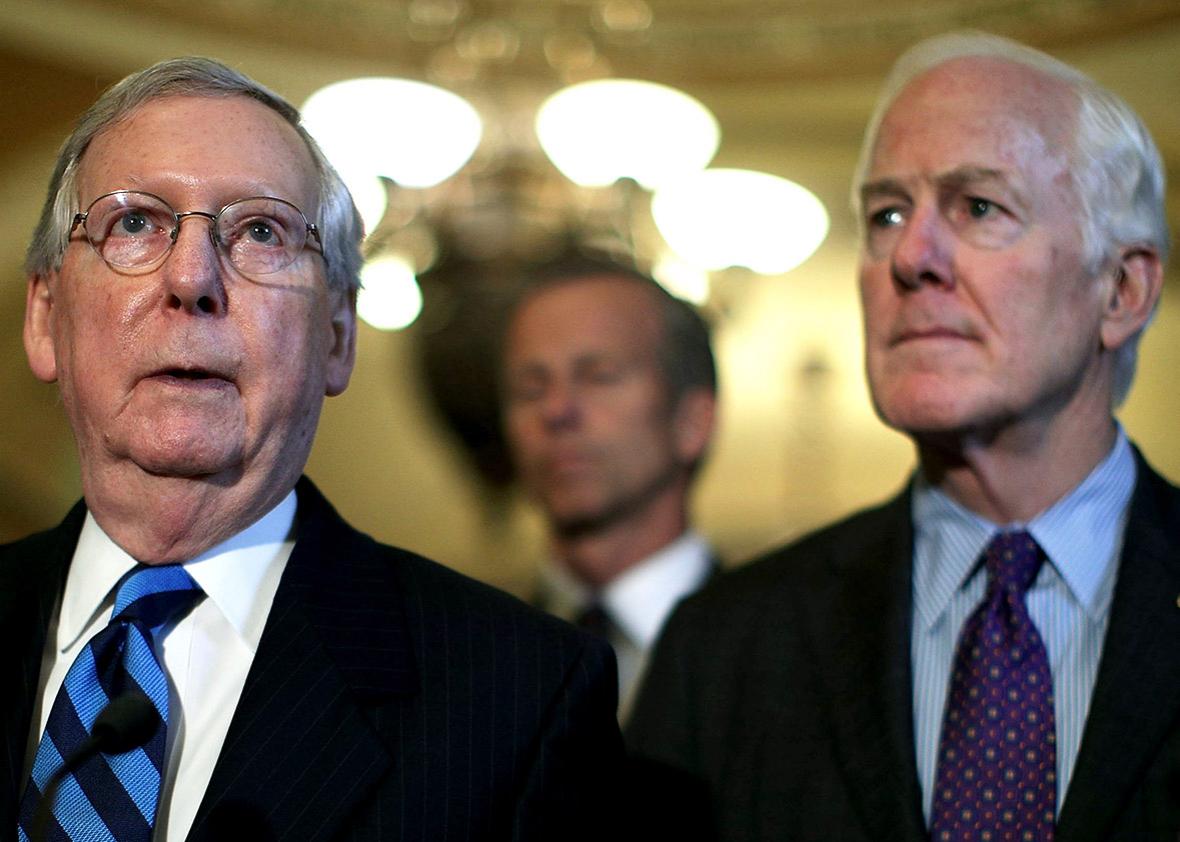The Senate on Tuesday finally voted down its comprehensive plan to repeal and replace Obamacare, the Better Care Reconciliation Act, by a vote of 57 to 43.* But that is not the end of that. Republican leaders now plan to pass a different, narrower repeal-only bill—which they have dubbed “skinny repeal”—and then allow something similar to their repeal-and-replace plan to re-emerge at the next step in the process, a conference committee between the House and Senate. Republicans could, effectively, advance the BCRA to the next step in the process without ever having passed it.
As of now, skinny repeal would only repeal the most unpopular parts of Obamacare: the individual and employer mandates, and the medical device tax. This narrow plan would crater insurance markets if it were to pass into law, but hey, it would also irritate Democrats and Barack Obama, which might be reason enough for it to get 50 Republican votes in the Senate. That would likely happen sometime early Friday, as the Senate wraps up its health care vote-a-rama.
If it does, one of two things could happen. The House could just take up skinny repeal and pass it, sending it to the president’s desk, where Trump would sign it. The House doesn’t love this idea—Freedom Caucus Chairman Rep. Mark Meadows said Wednesday that there was “zero” chance of it happening—but minds can be changed if it proves to be the best (and easiest) available option to passing something. The other option is the Senate and House could go to a conference committee to blend the Senate’s “skinny repeal” and the House’s American Health Care Act—the comprehensive repeal-and-replace plan it passed in May—into a final product that the House and Senate would each vote on.
If the latter happens, Senate Republicans are hoping that they could effectively recreate the Better Care Reconciliation Act in conference even though it never passed the Senate. And they also are hoping this time they would get a different result.
It’s been interesting to hear Senate Republicans over the past day overtly admitting that the bill they hope to pass by the end of the week, “skinny repeal,” is not really the bill they want to pass into law. They just want to use it as a vehicle to get to conference.
Tennessee Sen. Bob Corker went so far Wednesday as to say the “content” of the bill they pass is immaterial, so long as it can serve as a “forcing mechanism” to get it into committee. South Dakota Sen. Mike Rounds described “skinny repeal” in even more mechanical terms. It would serve two purposes, he told the Hill. First, it would allow House and Senate Republicans to get to conference. Second, in the Hill’s words, it would “buy time for the Congressional Budget Office to score the new proposals, including the Cruz and Portman amendments.”
The Senate Health Care Plan: a vehicle for getting to conference and a way to kill time until further analysis arrives. How soon can this be slapped on some bumper stickers?
Texas Sen. John Cornyn, the majority whip, listed the same two “benefits” of a “skinny repeal” bill. Getting to conference, Cornyn said, would be “giving us a good chance to get an outcome, which is my goal.” (Our goal: an outcome.)
Cornyn explained to me how the conference committee, in mixing the “skinny repeal” bill and the AHCA, could include provisions that are in neither. The House’s comprehensive bill would be used as a “template” for a new comprehensive bill. New provisions that aren’t in either of the two bills being blended together, then, can be included if they pass a relevancy test—i.e., if they’re in the same ballpark as something in either of the two bills being negotiated.
Consider the Cruz amendment, a BCRA provision that was not in the House bill. Cornyn pointed to a provision in the House bill that would allow anyone to purchase a catastrophic insurance plan, instead of just those younger than 30. Cornyn described this as the “hook” that would allow them to include the Cruz amendment, which would allow insurers to sell narrowly regulated plans so long as they also offer comprehensive ones.
That is Senate leaders’ plan: pass “skinny repeal”—hell, pass a doodle of a flying hamburger drawn on a scrap of paper—and then “hook” parts of the Senate’s comprehensive bill that never passed onto the AHCA “template,” to use Cornyn’s words, in a conference committee.
The obvious problem with this strategy is that the Senate leaders couldn’t pass a repeal-and-replace bill this time around, so why should they expect to be able to pass one next time? Trump will keep calling them out on Twitter. Senate leaders will try to apply the extra pressure of we’ve come this far, this is it, and you’re going to kill it to keep Obamacare in place? Three senators may well say that yes, they are indeed willing to. But I wouldn’t bet my health care on it.
This post has been updated.
*Correction, July 26, 2017: This article originally misstated that the Senate voted down the Better Care Reconciliation Act on Wednesday. It was on Tuesday. (Return.)
